Invited Speakers - DIMAT 2021
 |
Dr. Alain Portavoce received his PhD in Materials Science in 2002. He was offered a permanent position by the French National Center of Scientific Research (CNRS) in 2005, for joining the Institute of Materials Microelectronics and Nanoscience of Provence (IM2NP, Marseille), where he leads the “Reactivity and Diffusion at Interfaces” research team. His expertise includes elaboration (molecular beam epitaxy, magnetron sputtering…) and characterization (secondary ion mass spectrometry, Auger electron spectroscopy, Atom Probe Tomography…) of thin films and nanostructures. His work mainly concerns nanometer scale solid state diffusion, segregation, growth and reaction in materials involved in the fabrication of microelectronic devices (semiconductors, silicides, germanides…). |
 |
Prof. Aloke Paul heads the research group working on various aspects of diffusion in solids in the Department of Materials Engineering, Indian Institute of Science, Bangalore, India. Major research areas include developing new phenomenological models, materials in electronic packaging, bond coat in jet engine applications, the growth of A15 intermetallic superconductors etc. Recently his group has proposed the concept of pseudo-binary and pseudo-ternary diffusion couple methods in multicomponent systems. He has guided several Ph.D. and ME students and co-authored more than 100 articles in various international journals. He has also co-authored a textbook titled Thermodynamics, Diffusion and the Kirkendall effect in Solids and co-edited two volumes of Handbook of solid-state diffusion. |
 |
Prof. Gary S. Collins is Professor of Physics at Washington State University in the US Pacific Northwest. He received a BA degree in physics from colonial Rutgers College in New Jersey in 1966, was next a Peace Corps teacher of math/science in Togo, West Africa for two years, after which he returned to graduate school at Rutgers University. He taught and did research for eight years at Clark University in Massachusetts before taking a permanent position at WSU in 1985. He has a broad background applying nuclear methods to study the local structure of solids, especially perturbed angular correlation spectroscopy (PAC). His group has measured formation, migration, and interaction enthalpies of point defects such as vacancies with impurities in metals and compounds. How site-preferences of impurity atoms in compounds change as a function of composition and temperature has also been a subject of study. His group applied PAC for the first time to study atomic diffusion in compounds at high temperature through measurement of dynamical relaxation at nuclei of probe atoms caused by fluctuating atomic environments. He has been recipient of $3.6 M in grant awards from the Metals Program at NSF. He has mentored sixty-seven students from postdoctoral down to high-school levels and recently received an Outstanding Career Achievement Award from his college. |
 |
Prof. Helena Zapolsky is a Professor of Physics and head of modelling group in the Group of Materials Physics in the Department of Sciences at University of Rouen Normandy in France. She received her Ph.D. in Theoretical Physics from the Bogolyubov Institute for Theoretical Physics in Kiev, Ukraine. She was invited Research Scientist at University of Picardie Jules Verne, University of Toulon and University of Marseille Saint Charles in France. Her research areas include the theory and modeling of microstructural evolution in alloys, self-organization in complex systems, grain boundaries structure, and phase transition in magnetic materials. Computational techniques applied to these problems range from the atomic scale (atomic density theory) to the mesoscale (phase field method). Recently, with her collaborators, she developed a new atomistic approach based on the continuum atomic density function theory (quasiparticle approach) to model the kinetics of phase transformations in wide range of materials. |
 |
Prof. Helmut Mehrer was born 1939 in a village near Heilbronn, a city in Southern Germany. He visited the Robert-Mayer-Gymnasium in Heilbronn and studied physics at the University of Stuttgart and at the ETH Zürich in Switzerland from 1959 to 1964. He received his Diploma in Physics in 1965 under the guidance of Prof. Dr. H. Kronmüller with a thesis about magnetic properties of deformed and particle irradiated nickel monocrystals. He worked for his PhD until 1968 under the guidance of Prof. Dr. A. Seeger simulation of diffusion and reactions of point defects in crystals. He started an experimental group for diffusion studies with radioisotopes in solids in 1968 at the University of Stuttgart. He received his habilitation (venia legendi) in 1974 and was appointed apl. Professor in physics 1980. In 1984 Mehrer accepted the position of professor and director of the Institut für Metallforschung at the University of Münster as follower of Prof. Dr. Th. Heumann. Under Mehrer’s guidance the Institut was renamed to Institut für Materialphysik. About 180 scientific papers were published by Mehrer and his group in international scientific journals. From 1990 to 1992 Mehrer was dean of the physics department of the University of Münster. From 2000 to 2006 he was member and vice-speaker of a DFG Sonderforschungsbereich, in which his group cooperated with colleagues form physical and anorganic chemistry of the University of Münster. Mehrer retired in 2006. Mehrer was editor of a Landoldt-Börnstein data collection on Diffusion in Metals and Alloys in 1992. He co-edited the Conference Proceedings of DIMAT 1996 with the title Diffusion in Materials in 1997. DIMAT 1996 was organized by his group at Nordkirchen near Münster. Short after his retirement he published in 2007 a textbook with the title Diffusion in Solids. |
 |
Prof. Lijun Zhang is a full professor & Doctoral Supervisor at Central South University, Hunan, China. He was invited researcher in several laboratories, Thermo-Calc Software AB, Sweden; Ruhr-Universität Bochum, Germany; IM2NP, Aix-Marseille University, France; he was a Humboldt Research Fellow at Ruhr-Universität Bochum, Germany (2011-2012). He received several awards, among others: “121” Innovative Talent Training Program (3rd level) of Hunan Province, China (2019), CALPHAD Best Paper (2018), Excellent review for Metallurgical and Materials Transactions (2014), The Outstanding Ph. D Thesis Award by Hunan Province, China (2013), Humboldt Research Fellowship, Alexander von Humboldt Foundation, Germany (2011-2012), CALPHAD Scholarship Award, USA (2007). Prof. Lijun Zhang’s research interests include CALPHAD-based computational thermodynamics and kinetics in alloys, Phase-field model development, and simulation using software and house-made codes, Materials design driven by computational thermodynamics/kinetics, and machine learning. He is a co-author of several book chapters and more than 250 papers in print, H-index=32.
|
 |
Prof. Miklós Menyhárd received his PhD in 1984 and DsC in 1994. In his career he was involved in the study of surfaces and interfaces including surface and interface segregation. For interface studies he used ion beam sputtering which turned his interest to low energy ion-solid interaction. Presently he deals with the productions and characterization of functional nano layers produced by ion beam mixing. |
 |
Prof. Boris Bokstein was educated in Moscow Institute of Steel and Alloys and has gone a long wae from assistant to professor and chief of the physical chevistry department. Merited Scientist of Russian Federation, Emeritus Member of French Society of Metallurgy and Materials, Soros Professor, Gold Medal Russian Academie of Science. Fields of interest: thermodynamics and kinetics in materials science, diffusion and diffusion-controlled processes, diffusion and segregation in grain and phase boundaries. More 250 papers, 10 books, 4 text-books. H-index = 16; sum of times cited-920/ |
 |
Dr. Thomas Schuler obtained his Ph.D. after working at CEA Saclay/SRMP under the supervision of Maylise Nastar on the development of atomic-scale models to study the thermodynamics and kinetics of Fe-based systems explicitly accounting for vacancy-interstitials (C, N, O) interactions. Then he spent a year as a post-doc at the University of Urbana-Champaign, IL, USA working with Prof. Pascal Bellon and Prof. Dallas Trinkle. He showed that the addition of small amounts of solutes could be a very effective strategy to mitigate radiation effects by increasing point defects recombinations. Then he went for a new post-doc at the engineering school of Mines Saint-Etienne in France, to work with Prof. Frédéric Christien on co-segregation effects at grain boundaries, using DFT calculations and statistical mechanics models. At that time, he started developping the KineCluE code with Luca Messina and Maylise Nastar. KineCluE is an open-source code which implements the self-consistent mean-field theory to compute transport coefficients from atomic-scale input. Since 2018, he is a permanent researcher at CEA Saclay/SRMP where he pursues the development of the KineCluE code to make it applicable to a ever growing range of systems. |
 |
Dr. Xi Zhang is a postdoctoral researcher at the institute for materials science, university of Stuttgart, Germany. His research focuses mainly on ab initio density-functional-theory (DFT) based atomistic simulations of alloy thermodynamics (phase stabilities and phase transitions) and diffusion kinetics. The ab initio simulations are performed based on the finite-temperature DFT method, the cluster expansion technique, and kinetic Monte Carlo or molecular dynamic simulations. He is currently working on the project of ab initio simulations of diffusion in high entropy alloys. |
 |
Prof. Yuri Kaganovskii received the M.Sc. degree in solid-state physics in 1964, the Ph.D. degree in crystallography and crystal physics in 1970, and the D.Sci. degree in solid-state physics in 1984, all from the Kharkov State University, Kharkiv, Ukraine. From 1969 to 1988, he was a Senior Research Scientist with the Department of Crystal Physics, Kharkov State University, and from 1988 to 1995, he was a Professor with the same department. Since 2000, he has been an Associate Professor with the Department of Physics, Bar-Ilan University, Israel. He is the author of one monograph, more than 170 articles, and five inventions. His research interests include diffusion in solids, surface phenomena, photo-induced phenomena and mass transfer in thin solid films, light scattering at solids surfaces, and laser microfabrication. Dr. Kaganovskii is a member of the Editorial Board of Materials Letters journal. He was the recipient of the scientific awards of the Ministry of Higher and Secondary Special Education of the USSR, and the Inventor of the USSR medal from the USSR Committee. |
 |
Prof. Wolfgang Jäger received his Diploma and his Doctor degree (Dr rer nat, 1976) in Physics from the University of Stuttgart based on his research work at the Max-Planck-Institute for Metal Research, Stuttgart, Germany (Supervision Prof. Dr. Alfred Seeger). From 1977 to 1979 he joined the Materials Science Division at Argonne National Laboratory USA as a post-doc scientist. Starting 1979 he held positions of a staff scientist and of a group leader of a microstructure research group at the Institute for Solid State Research at the Forschungszentrum Juelich, Germany, until 1996. In 1996 he accepted an offer as Professor and Head of the Microanalysis of Materials Group at the CAU Christian-Albrechts-University of Kiel. He contributed to establishing the infrastructure of the Institute for Materials Science and the study course system for the MSc ‘Materials Science and Engineering’ degree. He initiated and coordinated several interdisciplinary activities at the University of Kiel. In 2013, he retired from his university teaching duties and since continues with research and further professional activities, such as serving as member of scientific advisory boards or co-organizing of scientific conferences and workshops on advanced transmission electron microscopy and its applications to current topics in materials and life science. He received and accepted numerous invitations as guest scientist (since 1995) from the Materials Research Laboratory, University of Illinois Urbana-Champaign, USA (1995), the National Institute for Materials Research, Tsukuba, Japan (1998), the National Center for Electron Microscopy NCEM LBL, Berkeley, USA(2007), the Institute of Engineering Innovation, The University of Tokyo (JSPS Fellowship Award 2015), Dept.Physics, Chalmers University of Technology, Gothenburg, Sweden (since 2013), and the Ernst-Ruska Centre for Microscopy and Spectroscopy with Electrons, Forschungszentrum Jülich, Germany (since 2015). His research interest focuses on advanced transmission electron microscopy and microstructure research in materials science for functional thin film materials and materials for energy. He published more than 300 scientific publications, including review articles and book chapters, and he has given numerous invited and plenary presentations at international conferences, in advanced scientific schools, and in institutes. |
|
Dr. Yongho Sohn is a Pegasus Professor and Lockheed Martin Professor of Engineering in the Materials Science and Engineering Department at University of Central Florida. He received his B.S. with honors and M.S. from Worcester Polytechnic Institute (Worcester, MA) in Mechanical and Materials Engineering, respectively. He graduated in 1999 with Ph.D. in Materials Engineering from Purdue University (West Lafayette, IN), and spent two years as a post-doctoral research scholar at the University of Connecticut (Storrs, CT). He joined University of Central Florida in 2001 as an assistant professor. His research and teaching interests includes metallic alloy powder processing and additive manufacturing, microstructural analysis and control, multicomponent intrinsic and interdiffusion in multiphase alloys, protective metallic/ceramic coatings for high temperature applications, light-weight metallic alloys and metal-matrix composites, and materials characterization. He has published 9 book chapters and over 200 journal papers. He is a Fellow of ASM International (FASM), recipient of NSF CAREER Award (2003), Outstanding Materials Engineer Award from Purdue University (2016), Engineer of the Year Award from Korean-American Scientists and Engineers Association (KSEA, 2020). |
|
 |
Prof. Maytal Caspary Toroker received her BA degree in molecular biochemistry (2004) and a direct-track PhD degree in theoretical chemistry (2009) at the Technion. After a postdoctoral period at Princeton University funded by the Marie Curie International Outgoing Fellowship from the European Union FP7 (2010-2013) program, she joined the Department of Materials Science in 2013 and is an Associate Professor since 2019. She received several awards for excellence, including International Association of Advanced Materials Award (IAAM-2015), L’Oréal-Unesco-Israel Award (2010), New England Fund (2009), Sara Lee Schupf Post-Doctoral Award (2008/9), and the Levi Eshcol Scholarship (2007-9). We use computational and theoretical tools to study metals and semiconducting materials. Using quantum mechanics, several material properties are characterized, including structure, electronic conductivity, and magnetism. Specifically, metal-oxide materials are optimized as materials that are able to better absorb solar energy and convert energy and chemicals into electricity and fuels. Applications include several energy converting devices, including photovoltaics and photoelectrochemical cells. |
|
Prof. Rafal Kozubski completed his Ph.D. from the Jagiellonian University in Kraków in 1984. From 1987 to 1988 he was a post-doc at the Strasbourg Institute of Physics and Chemistry of Materials (IPCMS), France. In 1988 and 1990 he was an academic visitor in the Institute for Applied Physics, Swiss Federal Institute of Technology, Zurich, Switzerland. From October 1993 to September 1995 he stayed at the Institute for Solid State Physics, University of Vienna, Austria as a Lise-Meitner Fellow. After having completed his habilitation (DSc) from the Jagiellonian University in Kraków in 1997 he worked there first as an associate professor (1997 – 2006). In 2006 he was appointed a full professor in the Jagiellonian University in Kraków, Poland. His international experience includes International Fellowship at the Queen’s University in Belfast (2006-2008) and visiting professorships at the L.Pasteur University in Strasbourg/University of Strasbourg, France (2007, 2008, 2009, 2010, 2011). In 2016 he was appointed a Conjoint Professor of the University of Newcastle, Australia. He published over 100 scientific papers in international reviewed journals and is an author of over 150 communications on international conferences. |
|
 |
Dr. Bernhard Gadermaier holds an MSc in molecular microbiology and obtained his Ph.D. under the supervision of Prof. H. Martin R. Wilkening at Graz University of Technology. He studies ionic conductivity in various glassy, amorphous and (nano)crystalline materials. Such material include solid electrolytes as well as active material for Li-ion batteries. The latter are also synthesized using genetically modified bacteriophages used as biological nanotemplate. |
| Prof. Boris Straumal | |
| Prof. Dominque Mangelinck | |
| Prof. Rafal Kozubski | |
| Prof. Andriy Gusak |
